Overall cross-border asset holdings, however, still
have to recover. The emerging alignment between common monetary and
fiscal measures through the adoption of the three European safety nets
and the Next Generation EU recovery programme seem to have been a
game-changer in this regard. The resilience of financial re-integration
to potential future shocks to the Economic and Monetary Union, however,
should be monitored going forward. The different phases of the pandemic
also went along with sizeable shifts between different corporate
financing tools and different financial intermediaries.
Financial integration and the structure of financial
markets and intermediaries are two key elements for the functioning of
the European Economic and Monetary Union (EMU). For example, they
influence the extent to which the risks from asymmetric shocks can be
shared and how the single monetary policy is transmitted across member
countries. The massive economic dislocations that the coronavirus
(COVID-19) pandemic caused in production, trade, investment, employment
and consumption also showed in financial systems. Financial stability
risks from the pandemic have been addressed elsewhere (De Guindos 2020,
ECB 2021, ESRB 2021, European Commission 2021b). In this column, we look
at high- and low-frequency indicators of financial integration and structure and discuss how they responded to the different phases of the pandemic and the policy measures taken.
Financial fragmentation, re-integration and resilience
Figure 1 puts the financial integration implications of the COVID
pandemic into historical perspective. The blue line indicates that
overall euro area financial integration, as measured by cross-border
price differentials in the most important financial markets, shows a
sharp deterioration at the start of the pandemic. Episodes of
price-based financial re-fragmentation are, however, not unprecedented.
The one that occurred between February and April 2020 reversed
substantially faster than in the case of other stress periods, notably
the Great Financial Crisis and the European sovereign debt crisis. The
downturn in overall cross-border asset holdings in the euro area
(quantity-based integration, as shown by the yellow line), however, did
not reverse yet for the latest available data. It was particularly
driven by unsecured money market lending and equity holdings. While both
dimensions of integration had recovered from the two previous crises,
they are still at moderate levels, relatively similarly to the early
years of the euro.
Figure 1 Price-based and quantity-based composite indicators of euro area financial integration
(quarterly data, price-based indicator: Q1 1995 – Q4 2020, quantity-based indicator: Q1 1999 – Q3 2020)
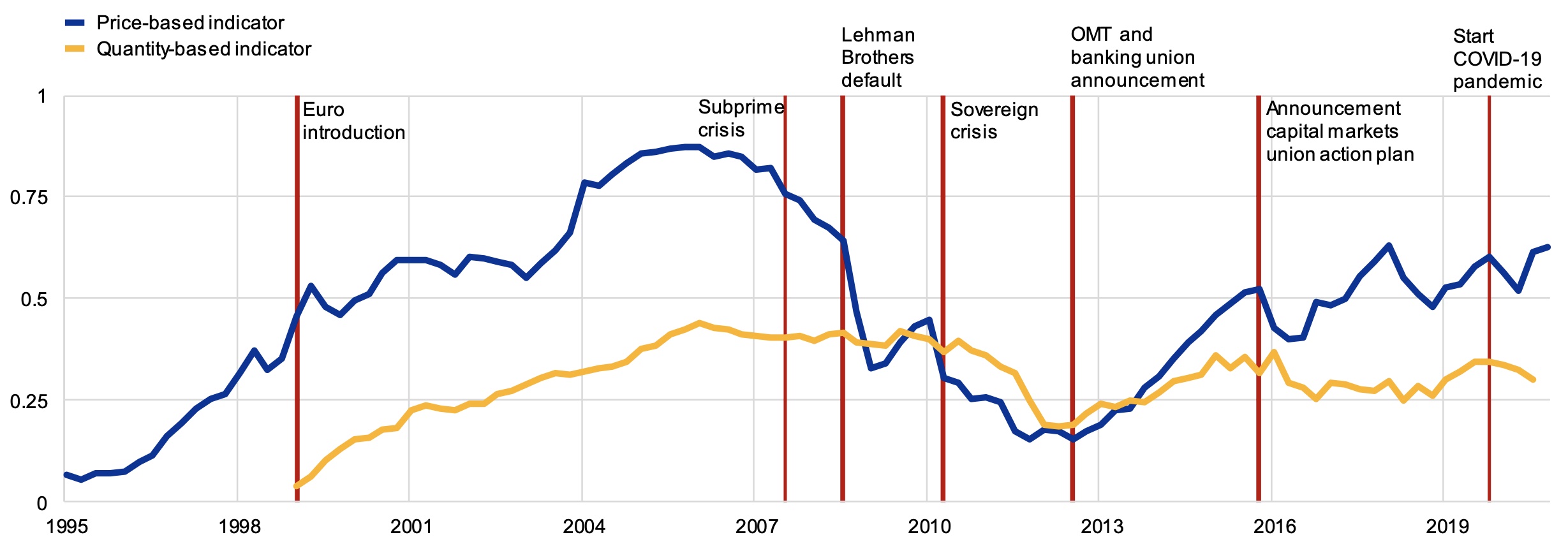
Sources: ECB and ECB calculations
Notes:
The price-based composite indicator aggregates ten indicators for money,
bond, equity and retail banking markets, while the quantity-based
composite indicator aggregates five indicators for the same market
segments except retail banking. The indicators are bounded between zero
(full fragmentation) and one (full integration). Increases in the
indicators signal greater financial integration. From January 2018
onwards the behaviour of the price-based indicator may have changed due
to the transition from EONIA to €STR interest rates in the money market
component. OMT stands for Outright Monetary Transactions. Detailed
descriptions of the indicators and their input data are in the Statistical Web Annex of ECB (2020) and Hoffmann et al. (2019).
Let us look in greater detail and at a high frequency at what
happened since the start of the pandemic in Europe, which we date around
mid-February 2020. Figure 2 shows a high-frequency version of the
price-based integration indicator (blue line), various measures of the
severity of the pandemic (COVID infections, COVID-related deaths,
vaccinations and lockdown stringency) and industrial production growth
as a measure of economic activity (red dots) for the euro area. The
vertical lines indicate selected key events and policy measures.
Building on Borgioli et al. (2020), it distinguishes between three
phases of the crisis, indicated by the grey and light blue shaded areas.
The first captures the first infection wave, with drastic lockdowns and
a severe economic downturn (mid-February to early May 2020). The second
phase covers the stark economic rebound when infections had returned to
low levels and member countries partly opened up again (early May to
mid/late-August 2020). The third phase spans the severe return of
infections in three more waves with, however, more targeted lockdowns
and a more resilient economy than during the first phase
(mid/late-August 2020 to end May 2021).
Figure 2 Euro area price-based financial integration, COVID-19 pandemic developments and events
(daily data, 17 February 2020 – 24 May 2021)
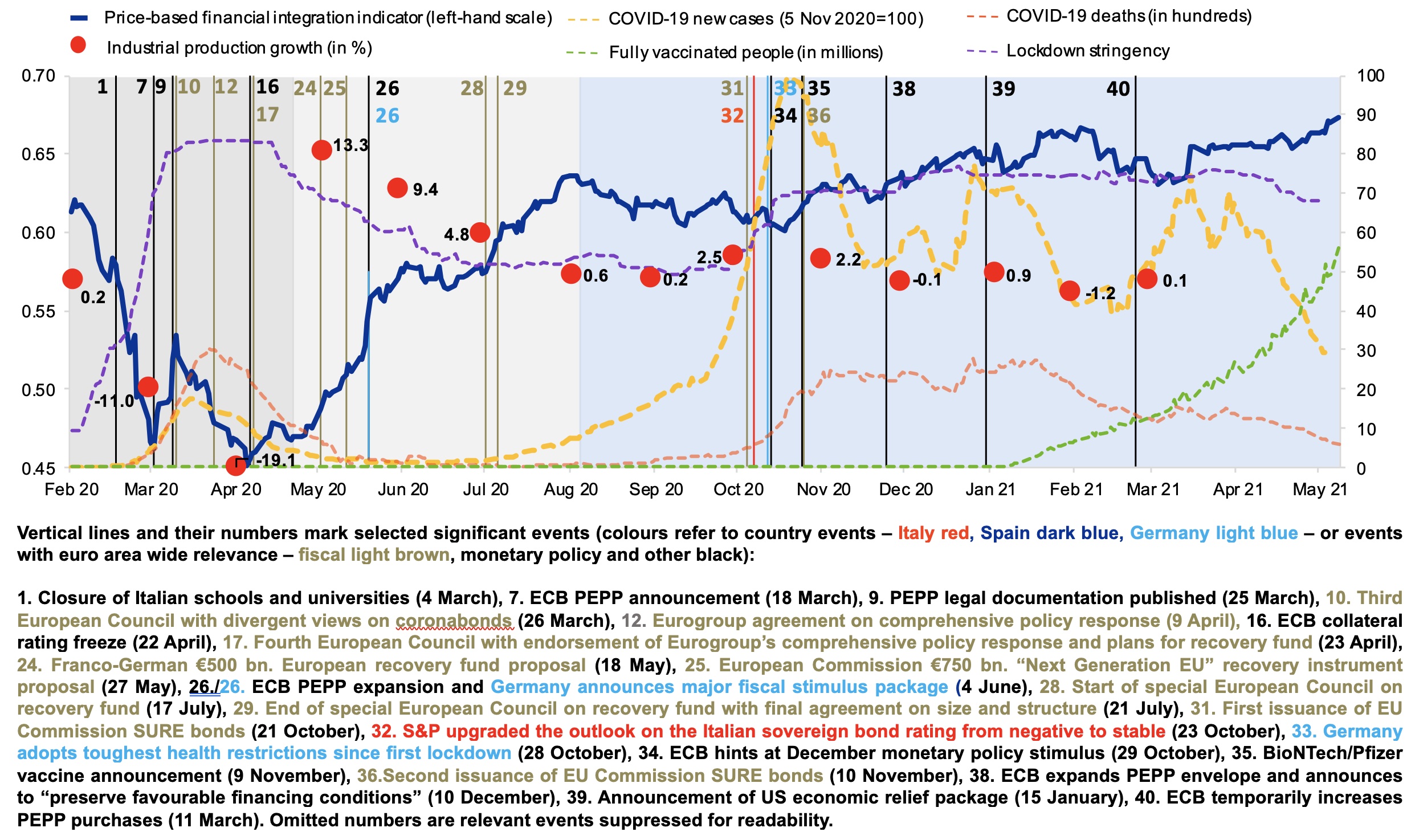
Sources: Price-based composite indicator and
industrial production: ECB and ECB calculations; COVID-19 new cases and
deaths: Bloomberg; fully vaccinated people and lockdown stringency index: Our World in Data.
Notes:
The price-based composite indicator of financial integration is a
high-frequency version (daily readings) of the one by Hoffmann et al.
(2019), described in Borgioli et al. (2020). The indicator is calibrated
to vary between 0 and 1. The COVID-19 new cases and the COVID-19 deaths
data series are measured as seven day moving averages. Industrial
production growth (excluding construction) is measured as growth rate to
the previous month. Lockdown stringency varies between 0 and 100 (100 =
strictest) and is computed as an average of the COVID-19 stringency
indexes of all euro area countries, weighted by their 2019 real GDP.
PEPP stands for Pandemic Emergency Purchase Programme and SURE for
Support to mitigate Unemployment Risks in an Emergency.
The figure clearly shows the sharp financial disintegration
tendencies in the euro area at the beginning of the crisis. These
tendencies were driven particularly by public and private bond markets,
but also by equity markets and later money markets (Borgioli et al.
2020, Figures 3 and 8). The first climax of the crisis is now often
described as the March 2020 ‘dash for cash’, when the demand for
money-like instruments spiked at the expense of other assets (Financial
Stability Board 2020). Not only did companies scramble for liquidity to
ensure their viability in the context of tightening and protracted
lockdowns, but also non-bank financial intermediaries came under
significant stress. High asset valuations prior to the onset of the
pandemic probably exacerbated the market correction towards the end of
2020Q1 (ECB 2020b, Section 2).
The cross-country fragmentation in financial markets can be explained
by the fact that the common cause of a health epidemic manifested
itself quite differently in member countries (Breitenfellner and
Silgoner 2020, Delatte and Guillaume 2020, Hernández de Cos 2021). This
was due – inter alia – to uneven speeds of virus contagion, differences
in health systems, industrial structures (balance of more versus less
affected sectors) as well as, notably, differences in public debt levels
and the fiscal space available to support the most affected companies
and households; so fundamental factors, but also market dynamics and
possible overreactions. In fact, early in the crisis, euro area
vulnerable countries’ sovereign spreads relative to Germany widened not
only as a consequence of the large expected fiscal costs for stabilising
their economies but also as a consequence of flight to safety into
German government bonds, driving their yields further into negative
territory. Still, while quite persistent, sovereign spreads remained way
below their peaks during the sovereign debt crisis.
The event lines in Figure 2 help us understand why this financial
fragmentation stopped and reversed relatively quickly, in contrast to
what happened during the Great Financial Crisis and the European
sovereign debt crisis. The policy response was very fast, both at the
national and the European level. Responding to low inflation outcomes
and distressed financial markets, the ECB introduced a series of new
monetary policy measures. National and EU supervisory authorities
adopted prudential relief measures. And national fiscal authorities were
quick in putting up large support programmes for companies and workers
most affected by lockdowns and other social distancing measures. For a
while, however, a source of uncertainty remained the time it took member
countries to agree on the necessary joint European fiscal response.
Yet, it still came along significantly faster than during the previous
twin crises a decade before (see events 12, 17, 24 and 25 in Figure 2).
(The OECD tackling coronavirus policy tracker provides comprehensive overviews of the most important policies.)
All these elements played their role in the stabilisation of the
economic and financial situation. But two areas seem to have been
particularly influential in breaking the fragmentation dynamics: the
ECB’s early (and continued) monetary policy interventions and a few key
aspects of the common European fiscal response. In an unscheduled
meeting on 18 March 2020, the ECB Governing Council launched the
Pandemic Emergency Purchase Programme (PEPP) (Lane 2020), which
increased the total envelope of sovereign and corporate asset purchases
by an initial €750 billion and allowed for a significant degree of
flexibility in allocating those purchases across assets (see events 7
and 9 in Figure 2). It is very visible in Figure 2 how the aggregate
financial integration indicator (blue line) immediately stopped its
‘free fall’ and reverted upwards to a large extent. Around the same
time, the ECB adopted a series of other monetary policy actions, such as
various types of longer-term refinancing operations at attractive rates
and eased collateral standards, as well as banking supervisory measures
such as capital, liquidity and operational relief and a recommendation
against dividend payouts.
Concerning the common fiscal response, the two most influential steps
were the agreements on three European safety nets for jobs, workers and
businesses for a total amount of €540 billion (events 12 and 17) and on
the European recovery fund, later called Next Generation EU (events 24,
25, 28 and 29). These new facilities foresee the joint issuance of debt
securities. They were further reinforced by the ECB freezing corporate
bond ratings in its collateral framework (event 16) and augmenting the
PEPP (event 26). Again, Figure 2 illustrates very clearly how some
temporary re-fragmentation reversed after the European Council adopted
the European safety nets on 23 April 2020 (event 17) and a
re-integration trend was set in motion and decisively solidified with
the Council’s agreement about the European recovery fund on 21 July 2020
(event 29).
This experience illustrates how powerful aligned monetary and fiscal
policies can be in a low interest rate environment, with large shocks
and vulnerable financial markets (see also Corradin et al. 2021). It is
also interesting to see in Figure 2 that the subsequent price-based
financial re-integration trend in the euro area continued until the
latest data, relatively undeterred by the following severe infection
waves (dashed yellow and orange lines), further lockdown measures
(dashed violet line) and a slow start of vaccination campaigns (event 35
versus green dashed line). The level of integration, as measured by
this high-frequency indicator, is higher by now than before the COVID-19
crisis.
How resilient is financial integration in the euro area at present?
The response matters should further adverse shocks hit. Figure 3 shows
four indicators of resilience based on cross-border asset holdings.
While resilience has increased substantially after the European twin
crises, for all indicators some type of reversal towards more liquid
securities with shorter maturities is visible; starting earlier for some
indicators than for others. Remarkably, in none of the indicators does
the COVID crisis seem to have accelerated the pre-existing trend. And in
three of the four, the trend seems to have bottomed out recently.
Still, vulnerabilities today seem to be greater than a few years ago and
it may be wise to take this observation into account when considering
exit strategies from unprecedented fiscal and monetary policy support.
Figure 3 Indicators of the resilience of financial integration in the euro area
(quarterly data, Q1 2008 – Q4 2020)
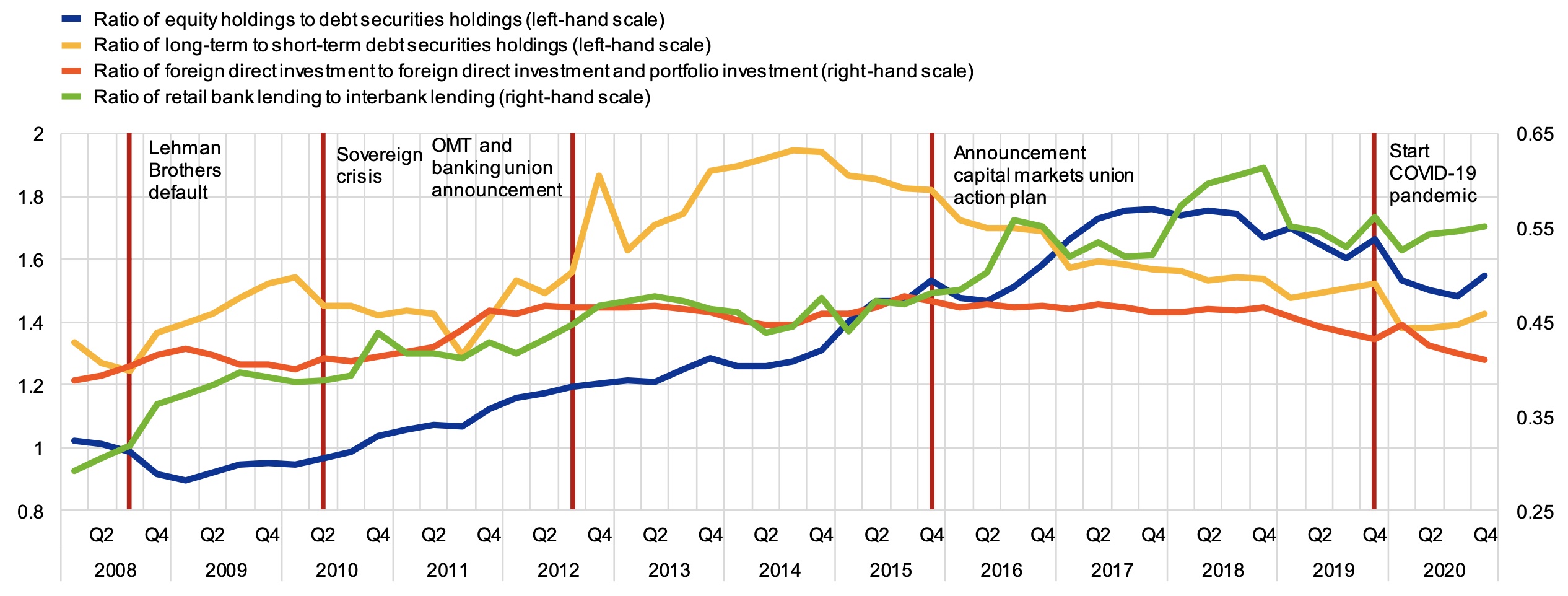
Sources: ECB.
Notes: The blue line shows
the ratio between the total amount of equity holdings by euro area
investors (all sectors) issued by residents of other euro area countries
and the total amount of debt securities holdings by euro area investors
(all sectors) issued by residents of other euro area countries. For
both equity and debt investments, the total refers to the sum of
intra-euro area cross-border and domestic asset holdings. The yellow
line shows the ratio between the total amount of long-term debt (with a
maturity of more than one year) issued by euro area countries and held
by residents of other euro area countries and the total amount of
short-term debt (with a maturity of less than one year) issued by euro
area countries and held by residents of other euro area countries. The
orange line shows the ratio between the total amount of intra-euro area
foreign direct investment and the sum of intra-euro area foreign direct
investment and intra-euro area cross-border portfolio investment. The
green line shows the ratio between the total amount of intra-euro area
cross-border bank lending to households and NFCs, i.e. retail bank
lending, and the total amount of intra-euro area cross-border lending
between Monetary and Financial Institutions, i.e. interbank lending. For
more discussion on the interpretation of these indicators, see Special
Feature A “Financial integration and risk sharing in a monetary union”
in the 2016 ECB report on “Financial integration in Europe”.
Changes in corporate financing and the structure of financial intermediaries
Turning from the state of financial integration to the euro area
financial structure, Figure 4 shows the development of non-financial
corporations’ (NFCs’) external financing in terms of flows during the
crisis compared to the year before. It should first be noted that the
NFC sector could be regarded as the economic epicentre of the COVID
pandemic, as a large part of it was shut down and went off as a producer
of goods and services, of inputs for other companies and as an employer
paying wages to consumers. From there the risks spread to consumers,
bank lenders, and governments forced to provide massive support.
Figure 4 External financing of euro area non-financial corporations by instrument
(quarterly flows, € billions, 2019‑2020)
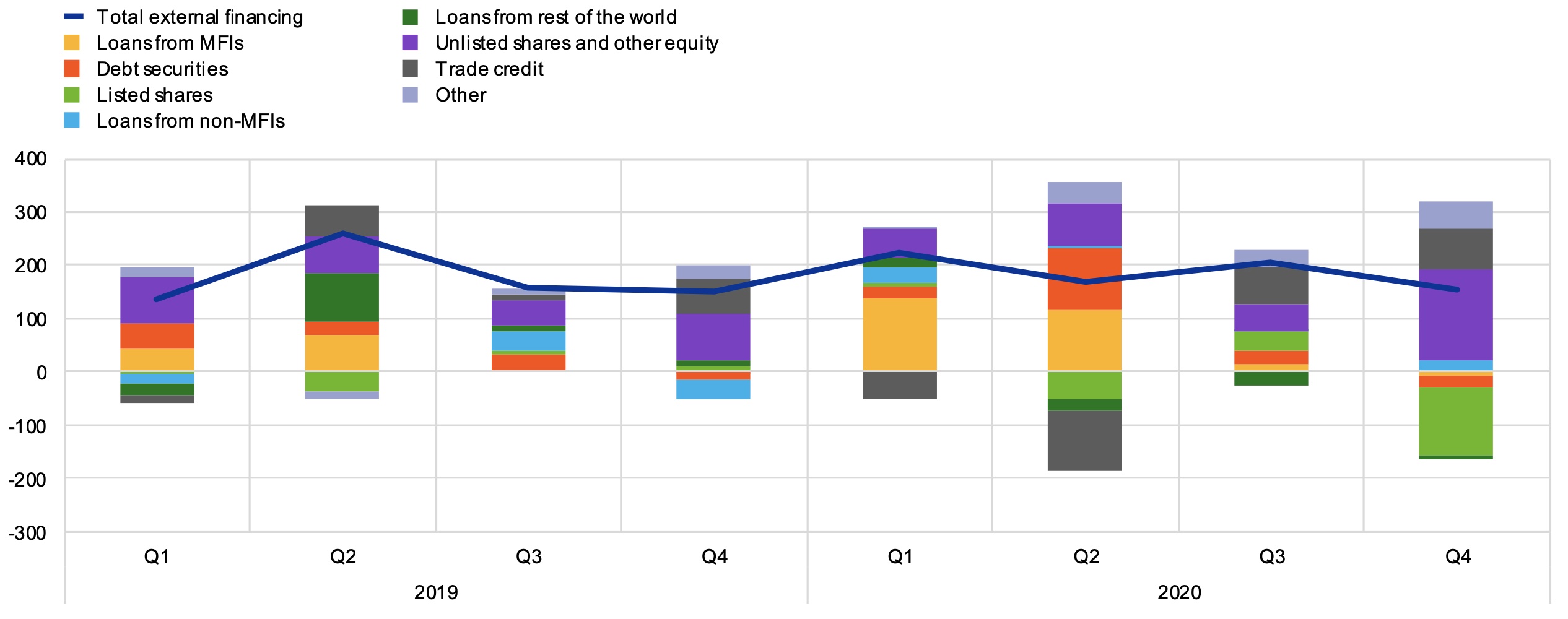
Sources: ECB (euro area accounts) and ECB calculations.
Notes:
MFI stands for Monetary and Financial Institutions. Non-MFIs include
other financial institutions (OFIs) as well as insurance corporations
and pension funds (ICPFs). "Other" is the difference between the total
and the instruments included in the figure and includes inter-company
loans and the rebalancing between non-financial and financial accounts
data.
The first, perhaps surprising, observation from the figure is that
total external financing during 2020 broadly held up compared with 2019.
The second is that significant reallocations across instruments
occurred during the pandemic. Notably, in the early phases of the crisis
NFCs borrowed significantly more from banks (yellow blocks in Figure 4)
and increased debt securities issuance (orange blocks; notwithstanding
large yield increases), thus creating precautionary liquidity buffers
and offsetting a substantial dry-up of trade credit (grey blocks).
Apparently, banks let companies draw elastically on credit lines during
the initial stages of the crisis, playing the valuable role of “elastic
nodes” in the financial system (Shin 2021). The debt securities boom in
2020 Q2 can be explained by the ECB stepping up its corporate asset
purchases, as part of the PEPP. (Higher bond and lower equity issuance
were also observed in the US; see Halling et al. 2020.) The evaporation
of trade credit in Q1 and Q2 (somewhat similarly to 2008 and 2009) is
likely to be related to the great uncertainty about the viability of
companies during lockdowns and, accordingly, trade credit recovered in
the second half of 2020 after the introduction of public support schemes
(including public guarantees and moratoria on insolvency rules; EBA
2020). For example, large firms may have resumed providing liquidity
support to their customers or smaller corporates postponing payments due
to cash constraints.
Next, we look at the euro area financial structure from the
perspective of the relative importance of different types of financial
intermediaries. The stock data on assets for the overall financial
sector in Figure 5 confirm the insight from the NFC liability flows in
Figure 4 that, since the start of the COVID crisis, banks grew in
importance by providing credit elastically (dark blue areas in the three
panels) and growing their assets by €2.3 trillion. Interestingly, other
financial institutions (OFIs; light blue areas) – which had grown in
the years before the crisis (ECB 2020) – decreased substantially (-€1.2
trillion), predominantly on account of reductions in their unlisted
share holdings.
Figure 5 Total assets of the euro area financial sector and shares of different types of financial intermediaries
(€ trillions (left panel; both scales), ratio of assets to nominal
GDP (middle panel), percentages (right panel), quarterly data, Q1 2017 -
Q4 2020)
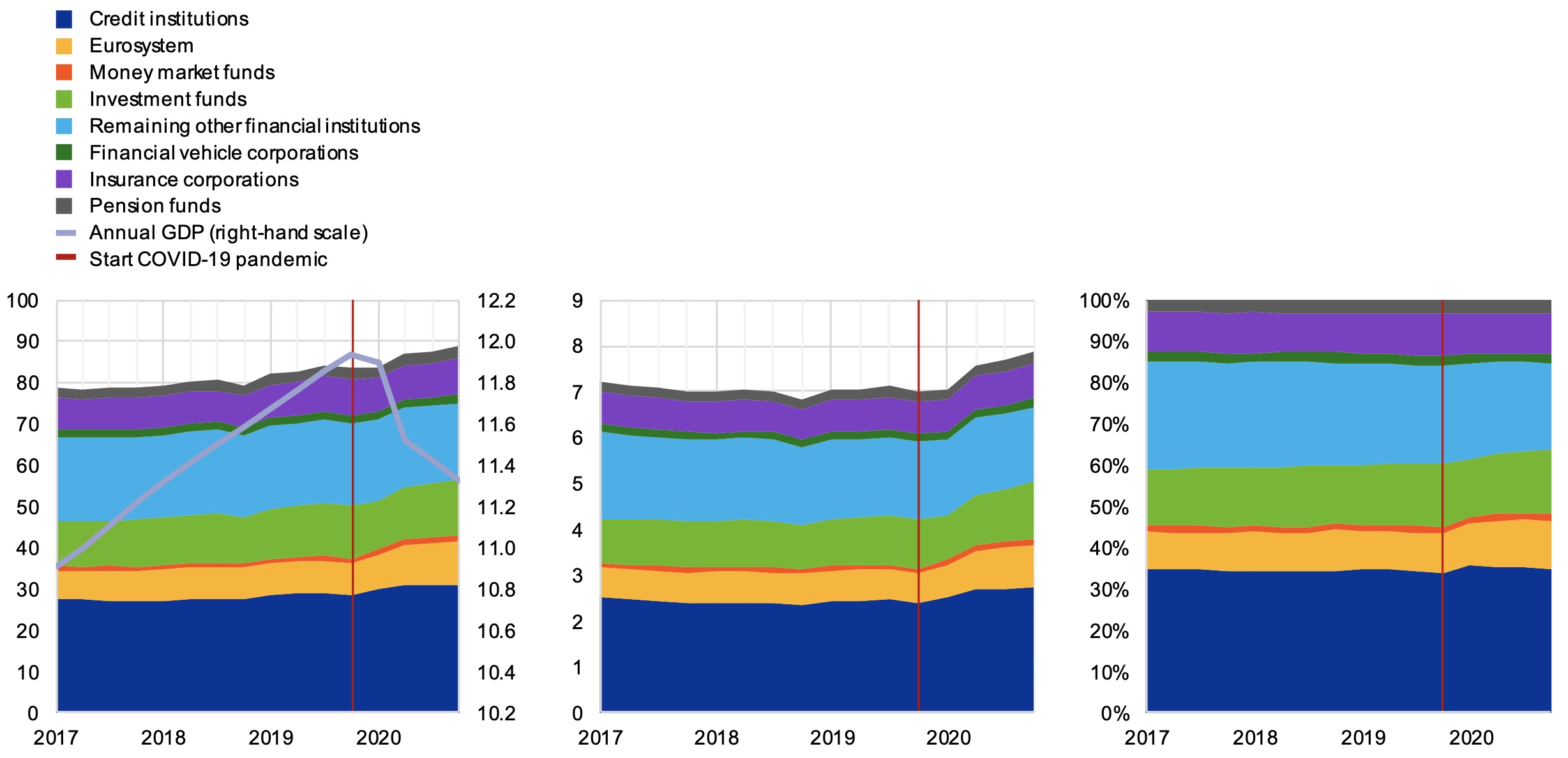
Sources: ECB.
Notes: The aggregated
(non-consolidated) assets of sub-sectors include financial assets and
exclude non-financial assets. Remaining other financial institutions
include security and derivative dealers, financial corporations engaged
in lending (such as leasing or factoring companies), specialised
financial corporations (including venture capital companies,
export/import financing companies or some central clearing
counterparties), financial auxiliaries (including for example asset
management companies, securities brokers, investment advisers, insurance
brokers or exchanges) as well as captive financial institutions and
money lenders (including for example financial holding companies,
funding vehicles of non-financial corporations – e.g. supporting their
debt securities issuance – and other entities that channel financial
flows within non-financial corporations). Data on money market funds are
reported separately from credit institutions only as of Q1 2006. Data
on financial vehicle corporations, which are undertakings carrying out
securitisation transactions, are reported separately from remaining
other financial institutions as of Q4 2009.
Many other developments in euro area financial sector assets were
particularly influenced by valuation effects. Once multiple
interventions had calmed financial market tensions, unprecedented
monetary and fiscal policies supported asset prices; and later prospects
of vaccinations and the coming recovery together with companies,
households and governments learning to better deal with social
distancing. This brought a type of de-coupling of equity and other asset
prices and the state of the business cycle (Igan et al. 2020). Money
market and investment fund assets grew by a combined €0.9 trillion,
predominantly on account of increased holdings and valuations of debt
securities and of equity of all types. Valuation effects also drove the
absolute size of total financial sector assets up (left-hand panel of
Figure 5), in addition to the increased ECB asset purchases through the
PEPP, although not necessarily at a faster pace than over the preceding
decade. This, together with the sharp economic contraction (grey line in
the left panel), pushed the ratio of total financial system assets to
GDP from 7 in 2019 Q4 to 7.8 in 2020 Q4 (middle panel of Figure 5).
Authors’ note: All views expressed are those of the authors and
should not be regarded as the views of the ECB or the Eurosystem.
References
Borgioli, S, C-W Horn, U Kochanska, P Molitor, F P Mongelli, “European financial integration during the COVID-19 crisis”, ECB Economic Bulletin 7, 12 November.
Breitenfellner, A and M Silgoner (2020), “’Viral divergence’: Heterogenous effects of the COVID-19 crisis in the euro area”, in Spezielle Kurzanalysen, Österreichische Nationalbank, Juni: 44-49.
Corradin, S, N Grimm and B Schwaab (2021), “Euro area sovereign bond
risk premia during the Covid-19 pandemic”, mimeo., European Central
Bank, 10 May, forthcoming ECB Working Paper.
De Guindos, L (2020), “The euro area financial sector in the pandemic
crisis”, speech at the 23rd Euro Finance Week, Frankfurt am Main, 16
November.
De Guindos, L (2021), “Climate change and financial integration”,
Keynote speech at the joint European Commission/ECB conference “European
Financial Integration and Stability”, 27 May.
Delatte, A L and A Guillaume (2020), “Covid 19: a new challenge for the EMU”, CEPII Working Paper No. 2020-08, July.
European Banking Authority (2020), “First evidence on the use of
moratoria and public guarantees in the EU banking sector”, Thematic Note
EBA/Rep/2020/31, November.
European Central Bank (2020a), Financial integration and structure in the euro area, Frankfurt am Main, March.
European Central Bank (2020b), Financial stability review, Frankfurt am Main, May.
European Central Bank (2021), Financial stability review, Frankfurt am Main, May.
European Commission (2021a), “The movement of capital and the freedom
of payments”, Commission Staff Working Document, SWD(2021) 68 final, 6
April.
European Commission (2021b), European financial stability and integration review, Brussels, May.
European Systemic Risk Board (2021), Prevention and management of a large number of corporate insolvencies, Frankfurt am Main, April.
Financial Stability Board (2020), Holistic review of the March market turmoil, report to the G20, 17 November.
Halling, M, J Yu, and J Zechner (2020), “How did COVID-19 affect firms’ access to public capital markets?”, Review of Corporate Finance Studies 9(3): 501-533.
Hernández de Cos, P (2020), “The European Central Bank’s monetary policy: response to the pandemic crisis and future challenges”, speech at the Universidad Autónoma de Madrid (English translation of the Spanish original), 3 March.
Hoffmann, P, M Kremer and S Zaharia (2019), “Financial integration in
Europe through the lens of composite indicators”, ECB Working Paper, No
2319, September.
Igan, D, D Kirti and S Martinez Peria (2020), “The disconnect between
financial markets and the real economy”, Special Notes Series on
COVID-19, International Monetary Fund, August.
Lane, P (2020), “The market stabilisation role of the pandemic emergency purchase programme”, The ECB Blog, 22 June.
Shin, H S (2021), “Central bank balance sheets and financial stability”, in Central Banks in a Shifting World, Proceedings of the 2020 virtual ECB Forum on Central Banking, European Central Bank, Frankfurt am Main, May, 295-300.